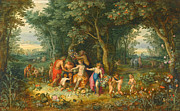Hendrick Van Balen
Paintings
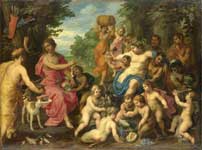
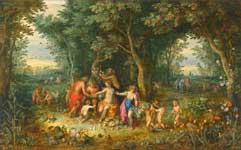

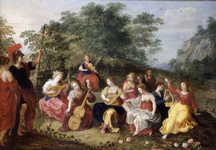

Diana Turns Actaeon into a Stag
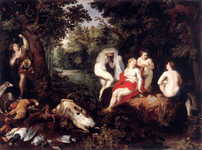
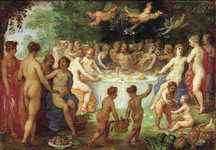
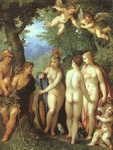
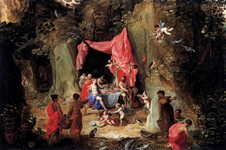
Odysseus as a Guest of the Nymph Calypso
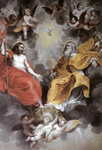
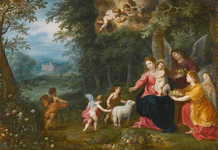
Virgin and Child with the Infant St John, Surrounded by Animals

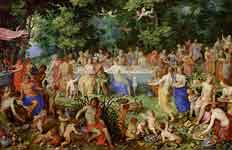
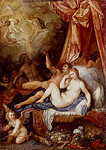
Venus and Mars Surprised by Vulcan
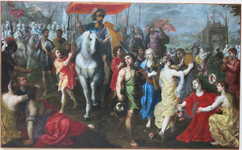
Triumph of king David after killing the philistine giant Goliath
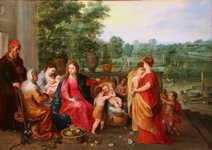
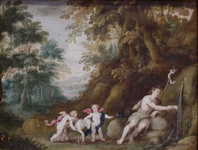
Saint John the Baptist in the Wilderness
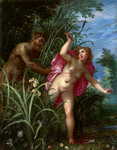


An Allegory of the Four Elements

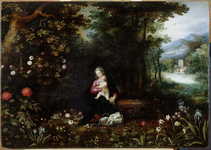
Wood landscape with rest on the flight to Egypt
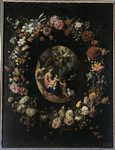
A garland of flowers and fruit with a central cartouche depicting the Holy Family
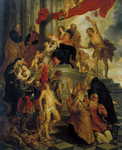
Mystic Marriage of Saint Catherine

The wedding of Thetis and Peleus
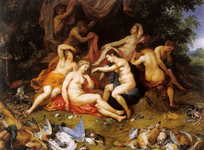
Diana and Her Nymphs Asleep, Spied Upon by Satyrs

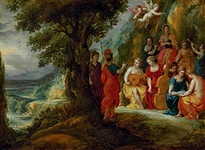
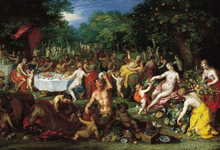
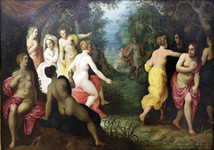
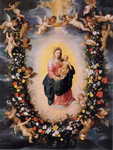
Madonna and Child in a floral garland
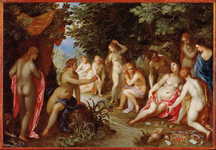
Fine Art Prints | Greeting Cards | Phone Cases | Lifestyle | Face Masks | Men's , Women' Apparel | Home Decor | jigsaw puzzles | Notebooks | Tapestries | ...
Hendrick van Balen or Hendrick van Balen I (1574 or 1575 in Antwerp – 17 July 1632 in Antwerp) was a Flemish Baroque painter and stained glass designer. Van Balen was a pupil of Adam van Noort and possibly also of Marten de Vos. He became a member of the Antwerp Guild of Saint Luke in 1592-1593 at the age of 17. In 1608-1609 he was the second dean of the Guild and in 1609-1610 he was the first dean. From about 1595 to 1602 he studied art while traveling in Italy. Although there is no record of his Italian journey, on his return to Antwerp, he became a member of the Guild of Romanists. It was a condition of membership that the member had visited Rome. In the year 1613 the Guild chose him as its dean.
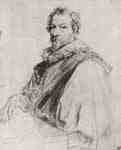
Portrait of the painter Hendrik van Balen, Anthony van Dyck
From about 1595 to 1602 he studied art while traveling in Italy.[2] Although there is no record of his Italian journey, on his return to Antwerp, he became a member of the Guild of Romanists. It was a condition of membership that the member had visited Rome. In the year 1613 the Guild chose him as its dean.
In 1605 Hendrick van Balen married Margriet Briers (or 'de Brier') in Antwerp. The couple had 11 children and three of their sons became painters: Jan van Balen, Gaspard van Balen and Hendrick van Balen the Younger. His daughter Maria married the painter Theodoor van Thulden.[1] In 1613 he accompanied Rubens and Jan on a diplomatic mission to the Dutch Republic. Here they met Hendrick Goltzius and other Haarlem artists.[3]
Van Balen led for over 30 years a successful workshop and had many pupils. He was the teacher of his son Jan van Balen, Anthony van Dyck and Frans Snyders. He was also a contemporary of many of the other famous Flemish artists, such as the Brueghels, Jan and Pieter.[4]
Work
General
Bacchus en Diana
Early in his career van Balen created a number of large altarpieces, which show the influence of his teacher Adam van Noort. His later altarpieces, with their rich and subtle palette, appear to have been painted after van Dyck's arrival in his studio. Hendrick van Balen also painted mythological or biblical scenes on small plates or copper plates. His works often included nude figures in a mythological or religious scene, set in an idyllic setting. He also painted landscapes.[1]
Van Balen often collaborated with other artists such as Joos de Momper, Gaspar de Witte, Jan Brueghel the Elder and the Younger and Rubens.[3]
Anthony van Dyck made a portrait of his teacher van Balen in 1627/1630. The painting is in the collection of the J. Paul Getty Museum.
Garland paintings
Hendrick van Balen played a role in the development of the genre of garland paintings, which typically show a flower garland around a devotional image or portrait. Together with Jan Brueghel the Elder, he painted the first known garland painting around 1607-1608 for Italian cardinal Federico Borromeo, a passionate art collector and Catholic reformer. Borromeo requested the painting to respond to the destruction of images of the Virgin in the preceding century and it thus combined both his interests in Catholic reform and the arts. Brueghel, the still life specialist, painted the flower garland, while van Balen painted the image of the Virgin.[5]
Garland of Fruit surrounding a Depiction of Cybele Receiving Gifts from Personifications of the Four Seasons
The genre of garland paintings was inspired by the cult of veneration and devotion to Mary prevalent at the Habsburg court (then the rulers over the Southern Netherlands) and in Antwerp generally. Garland paintings were usually collaborations between a still life and a figure painter. The genre was initially connected to the visual imagery of the Counter-Reformation movement.[6] It was further inspired by the cult of veneration and devotion to Mary prevalent at the Habsburg court (then the rulers over the Southern Netherlands) and in Antwerp generally.[6][5]
An example of a collaborative garland painting he made with Jan Brueghel the Elder is the Garland of Fruit surrounding a Depiction of Cybele Receiving Gifts from Personifications of the Four Seasons in the Mauritshuis. The medallion in the centre depicts Cybele, the goddess of Earth and Nature. Around the medallion hangs a garland of flowers, vegetables and fruit – a tribute to the goddess and an ode to plenty and fertility. Van Balen painted the medallion while Brueghel painted the abundant garland, the surrounding figures and the numerous animals.[7]
References
Carl Van de Velde. "Balen, Hendrik van, I." Grove Art Online. Oxford Art Online. Oxford University Press. Web. 8 Jul. 2014
Henrik van Balen biography in: Arnold Houbraken, De groote schouburgh der Nederlantsche konstschilders en schilderessen, 1718
Peter C. Sutton, Dutch & Flemish Paintings: The Collection of Willem Baron Van Dedem, frances lincoln ltd, 2002, p. 66
Hendrik van Balen at the Netherlands Institute for Art History (Dutch)
Susan Merriam, Seventeenth-Century Flemish Garland Paintings. Still Life, Vision and the Devotional Image, Ashgate Publishing, Ltd., 2012
David Freedberg, "The Origins and Rise of the Flemish Madonnas in Flower Garlands, Decoration and Devotion", Münchener Jahrbuch der bildenden Kunst, xxxii, 1981, pp. 115–150.
Garland of Fruit surrounding a Depiction of Cybele Receiving Gifts from Personifications of the Four Seasons in the Mauritshuis
Further Reading
Liedtke , Walter A. (1984). Flemish paintings in the Metropolitan Museum of Art. New York: The Metropolitan Museum of Art. ISBN 0870993569. (see index).
---
Fine Art Prints | Greeting Cards | Phone Cases | Lifestyle | Face Masks | Men's , Women' Apparel | Home Decor | jigsaw puzzles | Notebooks | Tapestries | ...
---
Artist
A - B - C - D - E - F - G - H - I - J - K - L - M -
N - O - P - Q - R - S - T - U - V - W - X - Y - Z
Retrieved from "http://en.wikipedia.org/"
All text is available under the terms of the GNU Free Documentation License


